airbag off AUDI R8 SPYDER 2012 Owners Manual
[x] Cancel search | Manufacturer: AUDI, Model Year: 2012, Model line: R8 SPYDER, Model: AUDI R8 SPYDER 2012Pages: 236, PDF Size: 59.24 MB
Page 13 of 236
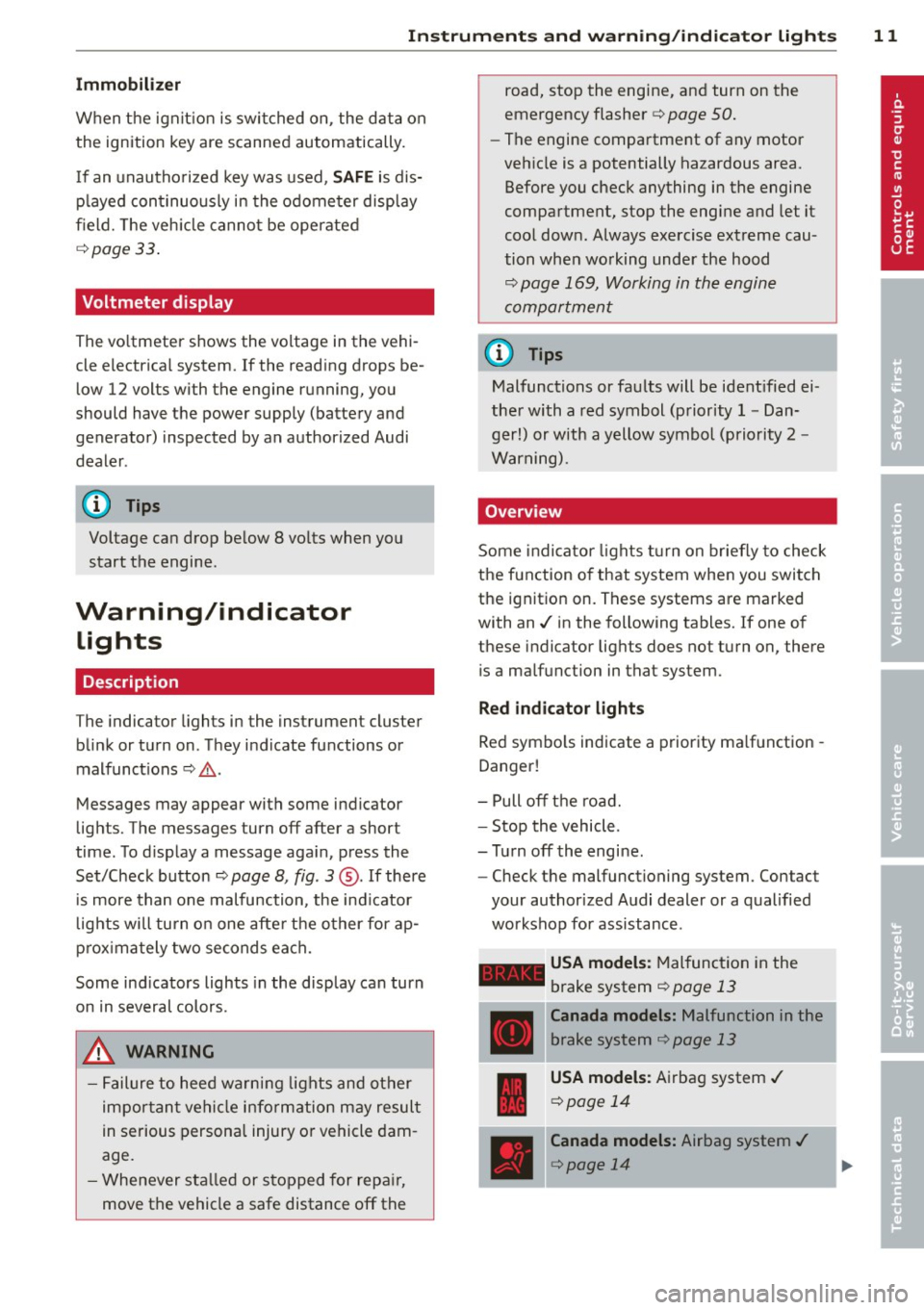
Instrument s and warnin g/indic ator ligh ts 11
Immobilizer
When the ignition is switched on, the data on
the ignition key are scanned automatically.
I f an unautho rized key was used,
SAFE is dis
p layed cont inuously in the odometer display
field. The veh icle cannot be operated
¢ page 33.
Voltmeter display
The vo ltmeter shows the voltage in the vehi
cle electrical system.
If the read ing drops be
low 12 volts with the engine running, you
should have the power supply (battery and
generator) inspected by an authorized Audi
dealer .
@ Tips
Voltage can drop below 8 volts when you
start the engine.
Warning/indicator Lights
Description
The indicator lights in the instrument cluster
blink or turn on . They indicate functions or
malfunct ions ¢,&..
Messages may appear with some indicator
lights. The messages turn off after a short
time . To d isplay a message aga in, press the
Set/Check button ¢
page 8, fig. 3 ® · If there
i s more than one malfunction, the ind icator
l ights will tu rn on one afte r the other for ap
prox imately two seconds each.
Some ind icators lights in the disp lay can turn
on in several colors.
A WARNING
- Failure to heed warning lights and other
importan t vehicle information m ay result
in serious persona l injury or vehicle dam
age.
- Whenever sta lled or s topped for repa ir,
move the vehicle a safe distance off the road, stop the engine, and turn on the
emergency flasher
¢ page 50.
- The engine compartment of any motor
veh icle is a potentially hazardous area.
Before you check anything in the engine
compartment, stop the engine and let it
coo l down. Always exercise extreme cau
tion when wo rking under the hood
¢ page 169, Working in the engine
compartment
(D Tips
Malfunctions or fau lts will be ident ified ei
the r with a red symbol (p riority 1 -Dan
ger!) or with a yellow symbol (priority 2 -
War ning).
Overview
Some indicator lights turn on briefly to check
the function o f that system when you swi tch
the ignition on. These systems are marked
with an./ in the following tables. If one of
these indicator lights does not turn on, there
is a ma lfunction in that system.
Red indicator lights
Red symbo ls indicate a priority ma lf u nction -
Danger!
- Pull off t he ro ad.
- Stop the vehicle.
- Turn off the engi ne.
- Check the malfunctioning system. Contact
your author ized Audi dealer or a qualified
workshop for assistance .
-USA models : Malfunction in the
brake system ¢
page 13
Canada models: Malfunction in the
b rake sys tem
¢ page 13
USA models: A irbag system./
¢ page 14
Canada models: Airbag system ./
¢page 14
Page 37 of 236

-In the event of a c rash with airbag de
ployment all locked doors will be auto
matically unlocked to g ive access to the
vehicle occupants from the outside .
- You are we ll advised not to keep valua
bles inside an unattended vehicle, visib le
or not . Even a properly locked vehicle
cannot p rovide the securi ty of a safe!
Unlocking/locking the vehicle with the
remote control
Fig. 30 Remote co n trol: functio n buttons
To unlock the vehicle~
.. Press button @ once ¢ fig. 30.
To lock the vehicle [ru
.. Press button @ once ¢ /A.
To unlock front lid only
.. Press button © for approximately one sec
ond .
PANIC Button
.,. Pu sh the red button @to activate the pan ic
function. The horn sounds and the turn sig
nal s flash .
.. Push the button @again to deactivate the
panic funct ion .
The turn s ignals flash twice when the vehicle
is unlocked . If the vehicle is un locked and a
door is not opened within the next 30 sec
onds, the veh icle locks again automatically.
This feat ure prevents the vehicle from be ing
left unlocked accidentally for a long period of
time .
Opening and closing 35
The turn signals briefly flash once and the
horn sounds once wh en the doo rs and front
li d are locked properly.
_& WARNING
Read and follow all WARNINGS ¢.&. in
General description on page 34.
(D Tips
- Use the remote contro l only when the
doors and front lid are closed.
- In order to make sure the locking func
tion is working, you should a lways keep
your eye on the vehicle to make sure it is
properly locked.
-
- Do not use the remote control if you are
inside the car, otherwise you may unin
tentionally lock the vehicle, and then you
would set off the anti-theft alarm when
you try to open a door . In case this hap
pens anyhow, push the unlock button@ .
- Use the pan ic function on ly if you are in
an eme rgency s ituation .
Operating locks with the key
To lock and unlock the vehicle from the out
side, turn the key in the lock of the driver 's
door .
Fig. 31 Key turn s fo r op eni ng an d clos ing
.. To unlock the vehicle, turn the key to the
opening position
@¢fig. 31.
.. To lock the vehicl e, turn the key in the lock
of the driver's door to the lo ck position @
¢&, . ....
Page 61 of 236
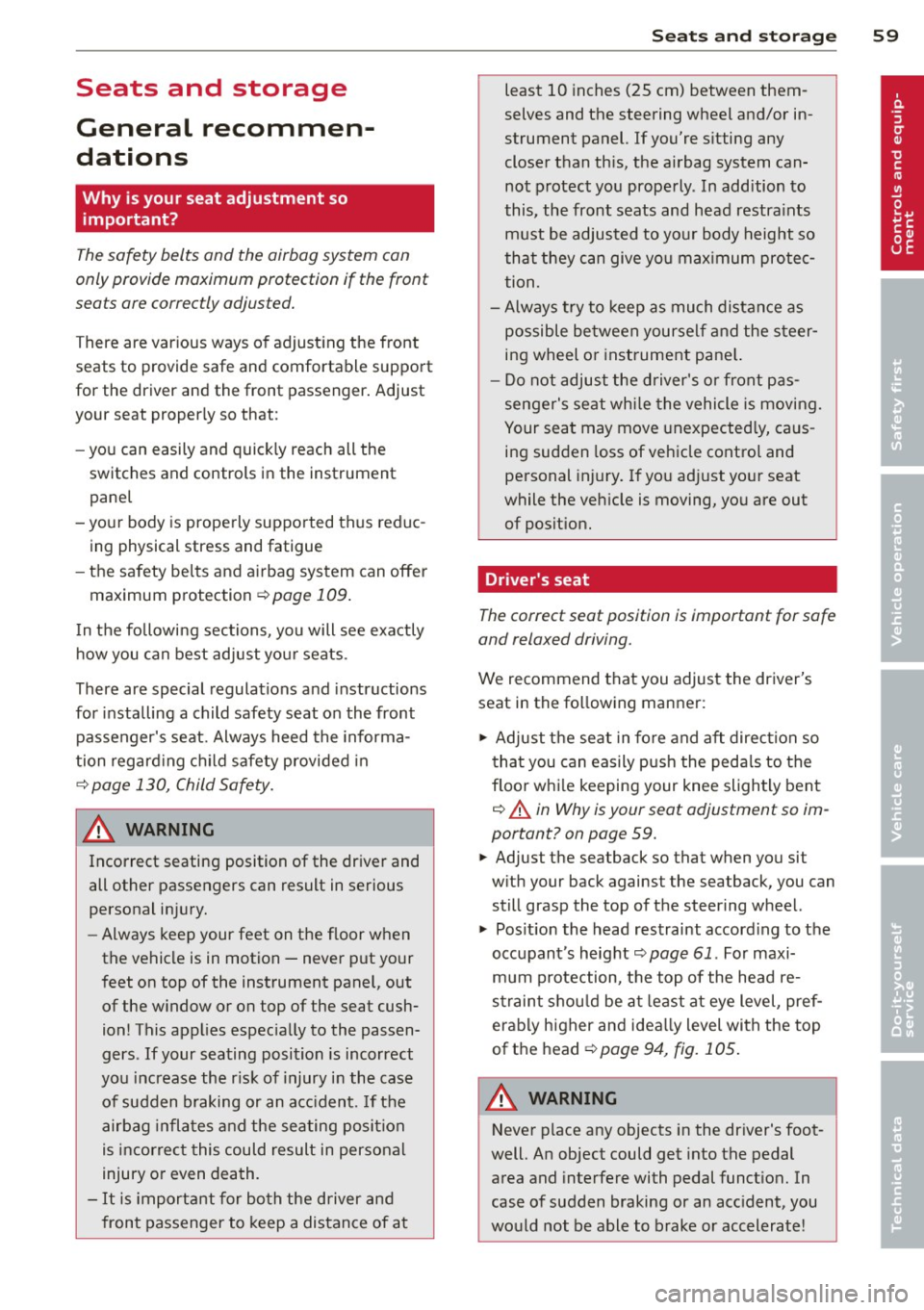
Seats and storage
General recommen
dations
Why is your seat adjustment so important?
The safety belts and the airbag system can
only provide maximum protection if the front
seats are correctly adjusted.
There are various ways of adjusting the front
seats to provide safe and comfortable support
for the driver and the front passenger. Adjust
your seat properly so that :
- you can easily and quick ly reach all the
switches and controls in the instrument
panel
- your body is properly supported thus reduc ing physical stress and fatigue
- the safety belts and airbag system can offe r
maximum protection
¢ page 109.
In the following sections, you will see exactly
how you can best adjust your seats .
There are special regulations and instructions
for installing a child safety seat on the front passenger's seat. Always heed the informa
tion regard ing child safety provided in
¢ page 130, Child Safety.
A WARNING
Incorrect seating position of the driver and
all other passengers can result in serious
personal injury.
- Always keep your feet on the f loor when
the vehicle is in motion -never p ut your
feet on top of the instrument panel, out
of the w indow or on top of the seat cush
ion! This applies espec ially to the passen
gers . If your seating position is incorrect
you increase the r isk of injury in the case
of sudden braking or an acc ident. If the
airbag inflates and the seating position
is incorrect this could result in personal
injury or even death.
- It is important for bo th the driver and
front passenger to keep a distance of a t
Seat s an d sto rage 59
least 10 inches (25 cm) between them
selves and the steering wheel and/or in
strument panel. If you're s itting any
closer than th is, the airbag system can
not protect you properly. In addition to
this, the front seats and head restra ints
must be adjusted to yo ur body height so
that they can give you max imum prote c
tion.
- Always try to keep as much distance as
possible be tween yourself and the s teer
ing wheel o r instrument pane l.
- Do not adjust the driver's or front pas
senger's seat whi le the vehicle is moving.
Your seat may move unexpected ly, caus
ing sudden loss of vehicle control and
personal injury . If you ad just yo ur seat
while the veh icle is moving, you are out
of posit ion.
Driver's seat
The correct seat position is important for safe
and relaxed driving.
We recommend that you adjust the driver's
seat in the fo llowing manner:
.,. Adjust the seat in fo re and aft direction so
t ha t you can easily push the peda ls to the
floor whi le keeping your knee sligh tly bent
c::> A in Why is your seat adjustment so im
portant? on page
59 .
.,. Adjust the seatback so that when you sit
w ith your back against the seatback, you can
still grasp the top of the steering wheel.
.,. Pos it ion the head restraint accord ing to the
occupant 's height
c::> page 61 . For maxi
mum protection, the top of the head re
straint shou ld be at least at eye level, pref
erably higher and idea lly level with the top
of the head
¢ page 94, fig. 105 .
A WARNING
Never place any objects in the dr iver's foot
well. An object could get into the pedal
area and interfere with pedal funct ion. In
case of sudden braking or an acc ident, you
would not be able to brake or accelerate!
Page 63 of 236

you do this while the vehicle is moving,
you will be out of position. Always adjust the driver's or front passenger seat when
the vehicle is not moving .
- Be careful when adjusting the seat
height. Check to see that no one is in the
way, or serious injury could result!
- Because the seats can be electrically ad
justed with the ignition key removed,
never leave children unattended in the
vehicle . Unsupervised use of the e lectr ic
seat adjustments may cause serious in
jury .
- To reduce the risk of injury in the case of
sudden braking or accident, front pas
sengers must neve r ride in a moving ve
hicle with the seatback reclined. Safety
belts and the airbag system offer maxi
mum protection on ly when the seatback
is upright and the safety belts are prop
erly posit ioned on the body. The more
the seatback is reclined, the greater the risk of personal injury from an incorrect
seating posit ion and improperly posi
tioned safety belts!
- Always make sure the front seatbacks are
in the upright position when dr iv ing .
Head restraints
Adjusting head restraints
Fig. 7 4 Adjusting head restra ints
The head restraints can be adjusted to provide
safe support to head and neck at the optimum
h e ight. When optimally adjusted, the top of
the restraint shou ld be level with the top of
the head . If that is not possible, try to adjust
S ea ts a nd s to rage 61
the head restraint so that it is as close to this
position as possible¢
page 94.
1-Grasp the sides of the head restraint with
both hands and slide it upward/downward
until you fee l it click into place
¢ fig . 74.
& WARNING ~ -
-Driving without head restraints or with
head restra ints that are not properly ad
justed increases the risk of ser ious or fa
tal neck injury dramat ically.
- Read and heed all WARNINGS
¢page 94.
@ Tips
Correct ly adjusted head restraints and
safety be lts are an extreme ly effective
combination of safety features.
Cup holder
F ig. 75 Cup holder
A WARNING
0 U)
~ ., a,
-
Spilled hot liquid can cause an accident
and personal injury.
- Never carry any beverage containers with
hot liq uids, such as hot coffee or hot tea,
in the vehicle while it is moving. In case
of an acc ident, sudden braking or other
veh icle movement, hot liquid could spill,
causing scalding burns. Spilled hot liquid
can also cause an accident and personal
lnJU ry.
- Use only soft cups in the cupholder . Hard
cups and glasses can cause injury in an
accident.
Page 72 of 236
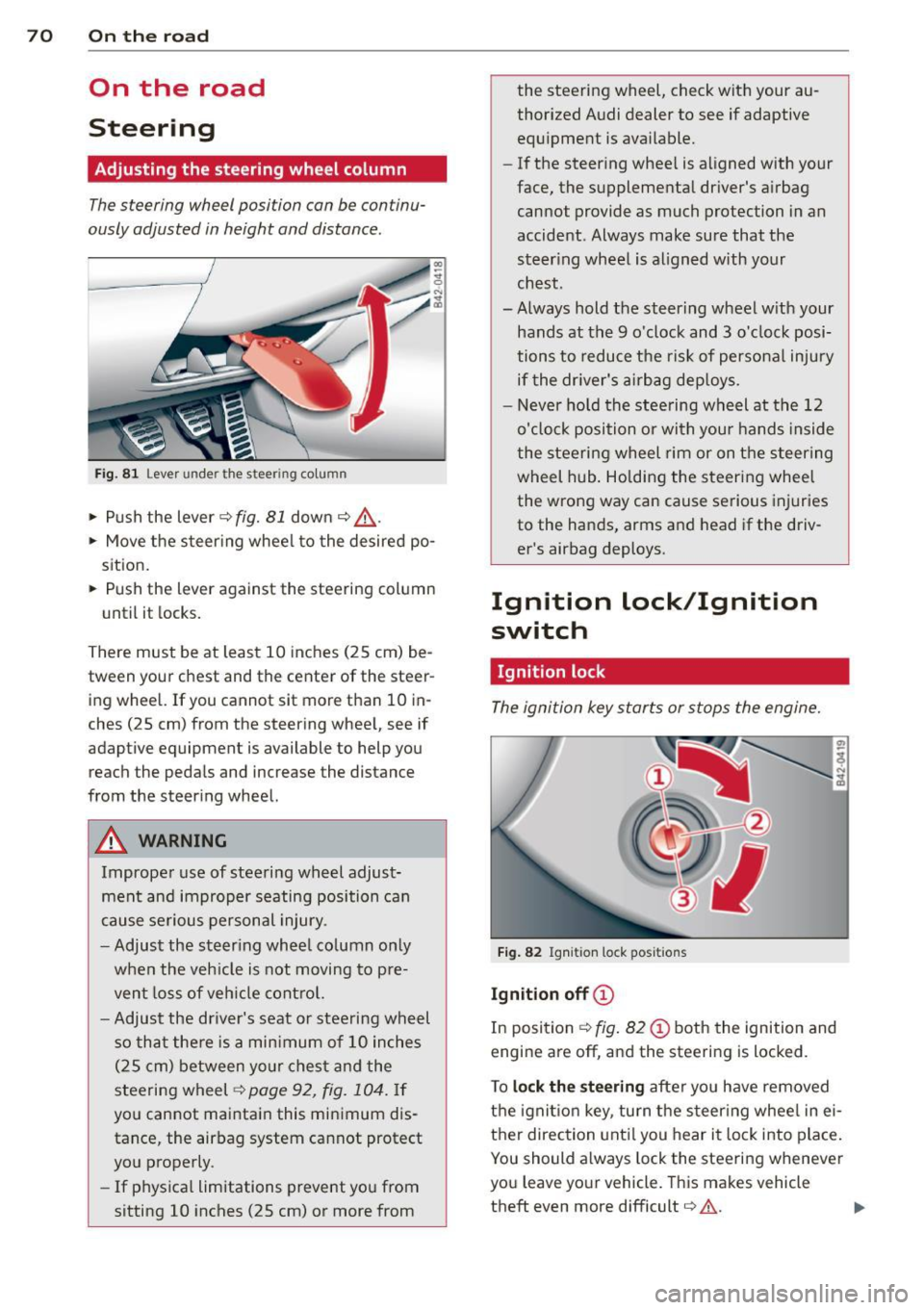
70 On the road
On the road
Steering
Adjusting the steering wheel column
The steering wheel position can be continu
ously adjusted in height and distance .
Fig. 81 Lever under the steering column
~ Push the lever¢ fig. 81 down ¢ .&_.
~ Move the s teer ing whee l to the desired po
sition.
~ Push the lever against the steering column
until it locks.
There must be at least 10 inches (25 cm) be
tween your chest and the center of the steer
ing wheel. If you cannot sit more than 10 in
ches (25 cm) from the steering wheel, see if
adaptive equipment is available to help you
reach the pedals and increase the distance
from the steer ing wheel.
A WARNING
Improper use of steering wheel adjust
ment and improper seating position can
cause serious personal injury.
- Adjust the steer ing whee l co lumn only
when the vehicle is not moving to pre
vent loss of veh icle control.
-
- Adjust the dr iver's seat or steering wheel
so that there is a minimum of 10 inches
(25 cm) between your chest and the
steering wheel ¢
page 92, fig. 104. If
you cannot maintain this minimum dis
tance, the airbag system cannot protect
you properly .
- If physical limitations prevent you from
sitting 10 inches (25 cm) or more from the steering wheel, check with your au
thorized Audi dealer to see if adaptive
equipment is
available.
- If the steer ing whee l is aligned with your
face, the supplemental dr iver's a irbag
cannot provide as much protection in an
accident . Always make sure that the
steer ing whee l is al igned with your
chest.
- Always hold the steering wheel w ith your
hands at the 9 o'clock and 3 o'clock posi
tions to reduce the risk of personal injury if the dr iver's airbag dep loys.
- Never hold the steering wheel at the 12
o'clock position or with you r hands inside
the steering wheel rim or on the steering
wheel hub . Ho lding the steering wheel
the wrong way can cause serious injuries
to the hands, arms and head if the driv
er's airbag deploys.
Ignition lock/Ignition
switch
Ignition lock
The ignition key starts or stops the engine.
Fig . 82 Ignit ion lock positions
Ig niti on off ©
In position ¢ fig. 82 (D both the ignition and
engine are
off, and the steering is locked .
T o
loc k t he steerin g after you have removed
the ignition key, turn the steering wheel in ei
ther direction unt il you hear it lock into place.
You should a lways lock the steering whenever
you leave your vehicle. This makes vehicle
theft even more difficult¢&. .
Page 96 of 236

94 Driving Safely
-Passengers who are unbelted, out of po
sition or too close to the airbag can be
seriously injured by an airbag as it de
ploys with great force in the blink of an
eye.
- Always make sure that there are at least
10 inches (25 cm) between the front
passenger's breastbone and the instru
ment panel.
- Always make sure that there are at least
4 inches (10 cm) between the front pas
senger's knees and the lower part of the
instrument panel.
- Each passenger must always sit on a seat
of their own and properly fasten and
wear the safety belt belonging to that
seat.
- Before driving, always adjust the front
passenger seat and head restraint prop
erly.
- Always keep your feet on the floor in
front of the seat. Never rest them on the
seat, instrument panel, out of the win
dow, etc. The airbag system and safety
belt will not be able to protect you prop
erly and can even increase the risk of in
jury in a crash.
- Never drive with the backrest reclined or
tilted far back! The farther the backrests
are tilted back, the greater the risk of in
jury due to incorrect positioning of the
safety belt and improper seating posi
tion.
- Children must always ride in child seats
r:::;, page 130. Special precautions apply
when installing a child seat on the front
passenger seat
r:::;, page 109.
Proper adjustment of head restraints
Fig. 105 Head restra int: v iewed from the front
The head restraints must be correctly adjust
ed to achieve the best protection.
.,. For adjustable head restraints : adjust the
head restraint so the upper edge is as even
as possible with the top of your head. If that
is not possible, try to adjust the head re
straint so that it is as close to this position
as possible
r:::;, fig. 1 OS .
Adjusting head restraints<=> page 61.
A WARNING ~
Driving without head restraints or with im-
properly adjusted head restraints increases
the risk of serious injuries in a collision . To
help reduce the risk of injury:
- Always drive with the head restraints in
place and properly adjusted.
- Every person in the vehicle must have a properly adjusted head restraint.
- Always make sure each person in the ve
hicle properly adjusts their head re
straint . Adjust the head restraints so the
upper edge is as even as possible with
the top of your head.
If that is not possi
ble, try to adjust the head restraint so
that it is as close to this position as pos
sible,
- Never attempt to adjust head restraint
while driving. If you have driven off and
must adjust the driver headrest for any
reason, first stop the vehicle safely be
fore attempting to adjust the head re
straint .
Page 104 of 236
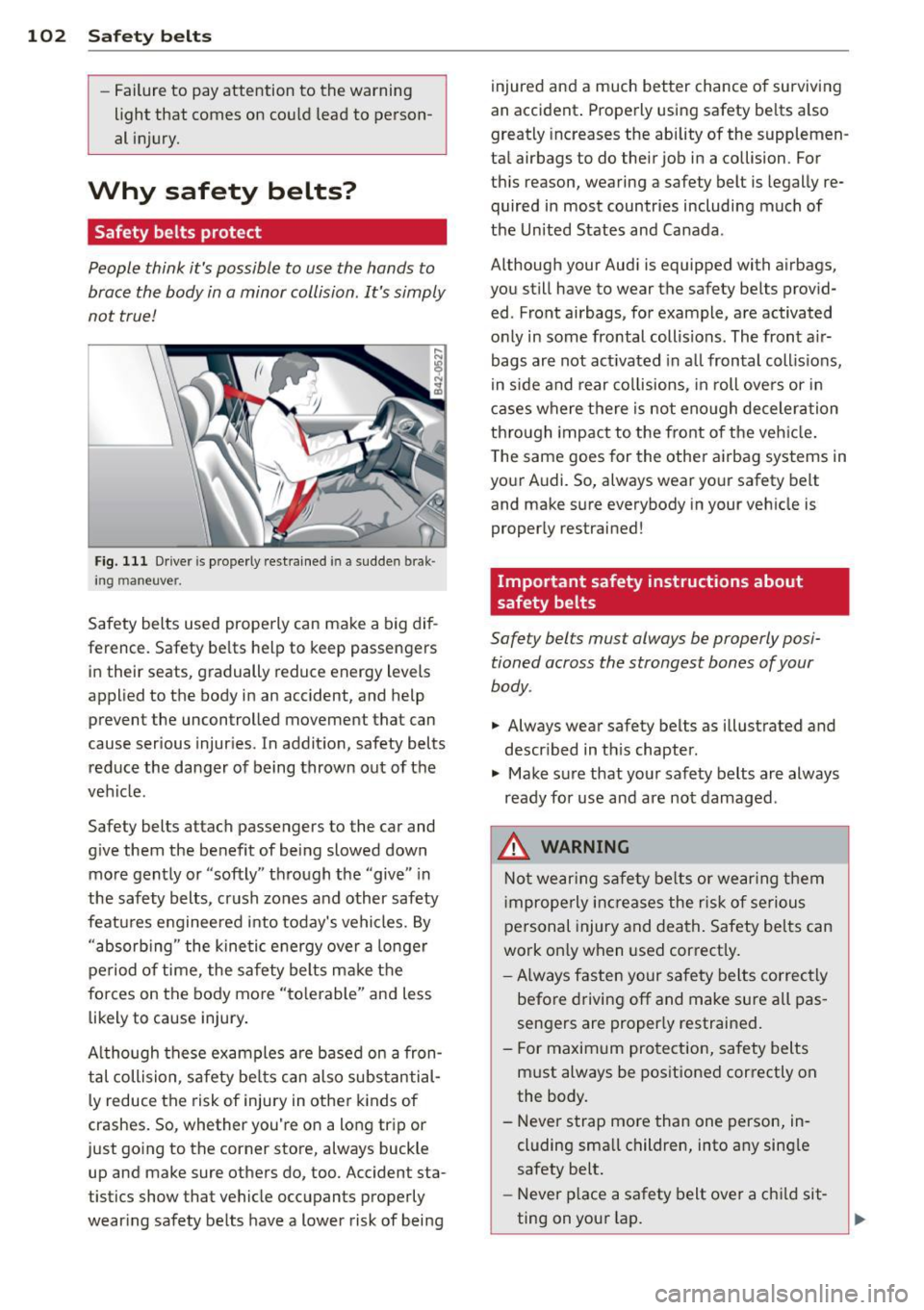
102 Safety belts
-Failure to pay attention to the warning
light that comes on could lead to person
al injury.
Why safety belts?
Safety belts protect
People think it's possible to use the hands to
brace the body in a minor collision. It's simply
not true!
Fig. 111 Driver is properly restrained in a sudden brak
i ng maneuve r.
Safety belts used properly can make a big dif
ference. Safety belts help to keep passengers
in their seats, gradually reduce energy levels
applied to the body in an accident, and help prevent the uncontrolled movement that can
cause serious injuries. In addition, safety belts
reduce the danger of being thrown out of the
vehicle .
Safety belts attach passengers to the car and
give them the benefit of being slowed down more gently or "softly " through the "give" in
the safety belts, crush zones and other safety
features engineered into today's vehicles. By
"absorbing " the kinetic energy over a longer
period of time, the safety belts make the
forces on the body more "tolerable" and less likely to cause injury.
Although these examples are based on a fron
tal collision, safety belts can also substantial
ly reduce the risk of injury in other kinds of
crashes. So, whether you're on a long trip or
just going to the corner store, always buckle up and make sure others do, too. Accident sta
tistics show that vehicle occupants properly
wearing safety belts have a lower risk of being injured and a much better chance of surviving
an accident. Properly using safety belts also
greatly increases the ability of the supplemen
tal airbags to do their job in a collision . For
this reason, wearing a safety belt is legally re
quired in most countries including much of
the United States and Canada.
Although your Audi is equipped with airbags,
you still have to wear the safety belts provid ed . Front airbags, for example, are activated
only in some frontal collisions . The front a ir
bags are not activated in all frontal collisions,
in side and rear collisions, in roll overs or in
cases where there is not enough deceleration
through impact to the front of the vehicle.
The same goes for the other airbag systems in
your Audi. So, always wear your safety belt
and make sure everybody in your vehicle is
properly restrained!
Important safety instructions about
safety belts
Safety belts must always be properly posi tioned across the strongest bones of your
body .
.,. Always wear safety belts as illustrated and
described in this chapter .
.,. Make sure that your safety belts are always
ready for use and are not damaged.
_&. WARNING
Not wear ing safety belts or wearing them
improperly increases the r isk of serious
personal injury and death. Safety belts can
work only when used correctly.
-Always fasten your safety belts correctly
before driving off and make sure all pas
sengers are properly restrained.
- For maximum protection, safety belts
must always be positioned correctly on
the body.
- Never strap more than one person, in cluding small children, into any single
safety belt.
- Never place a safety belt over a chi ld sit
ting on your lap.
Page 106 of 236
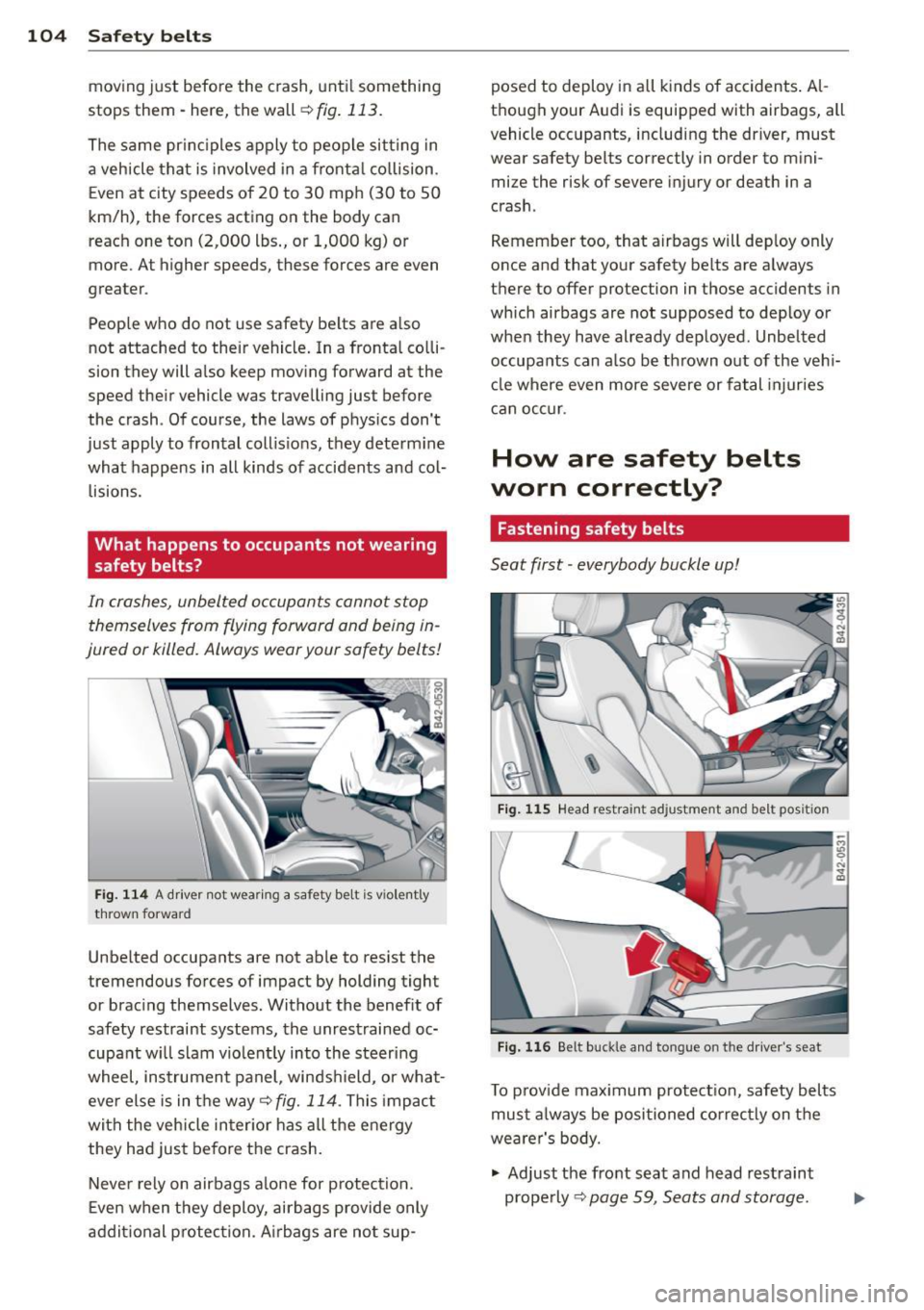
104 Safet y belt s
moving just before the crash, unti l something
stops them· here, the wall
r::!;> fig. 113.
The same pr inc iples apply to people sitting in
a veh icle that is involved in a fronta l co llision .
Even at city speeds of 20 to 30 mph (30 to 50
km/h), the forces acting on the body can
reach one ton (2,000 lbs., or 1,000 kg) or
more. At higher speeds, these forces are even
greater .
People who do not use safety be lts are a lso
not attached to their vehicle. In a fronta l co lli
sion they will also keep mov ing forward at the
speed their vehicle was trave lling just before
the crash . Of course, the laws of physics don't
just apply to frontal coll is io ns, they determ ine
what happens in all kinds of accidents and col·
lisions.
What happens to occupants not wearing
safety belts?
In crashes, unbelted occupants cannot stop themselves from flying forward and being in
jured or killed. Always wear your safety belts!
Fi g. 114 A driver not wear ing a safety belt is violently
t h rown forward
Unbe lted occupants are not able to res ist the
tremendous fo rces of impact by holding tight
or brac ing themselves. Without the benef it of
safety restraint systems, the unrestrained oc·
cupant w ill slam vio lent ly into the steering
wheel, instrument panel, winds hield, or what
eve r else is in the way¢
fig. 114. This impac t
with the veh icle inter ior has all the energy
they had just befo re the crash.
Neve r rely on airbags a lone for p rotection.
E ven when they deploy, airbags provide only
a d dit ional p rotec tion. A irbags are no t sup- posed to deploy
in all k inds of accidents . Al
though your Audi is equipped with airbags, all
vehicle occupants, includ ing the driver, must
wear safety belts correctly in order to mini
mize the risk of severe injury or death in a
crash .
Remember too, that airbags will dep loy only
o nce and that your safety belts are always
there to offer protection in those accidents in
which airbags are not supposed to dep loy or
when they have already dep loyed. Unbelted
occupa nts can a lso be th rown out of the veh i
cl e where even more severe or fatal injuries
ca n occ ur.
How are safety belts
worn correctly?
Fastening safety belts
Seat first · everybody buckle up!
Fig . 115 Head restraint adjustment and belt position
Fig. 116 Be lt buck le an d tongue on the dri ver's seat
To p rov ide max imum protect ion, safety belts
mus t always be posi tioned co rrec tly on the
wea rer's body.
.. Adjust the fro nt seat and head rest raint
p rope rly
r::!;> page 59, Seats and storage.
Page 111 of 236
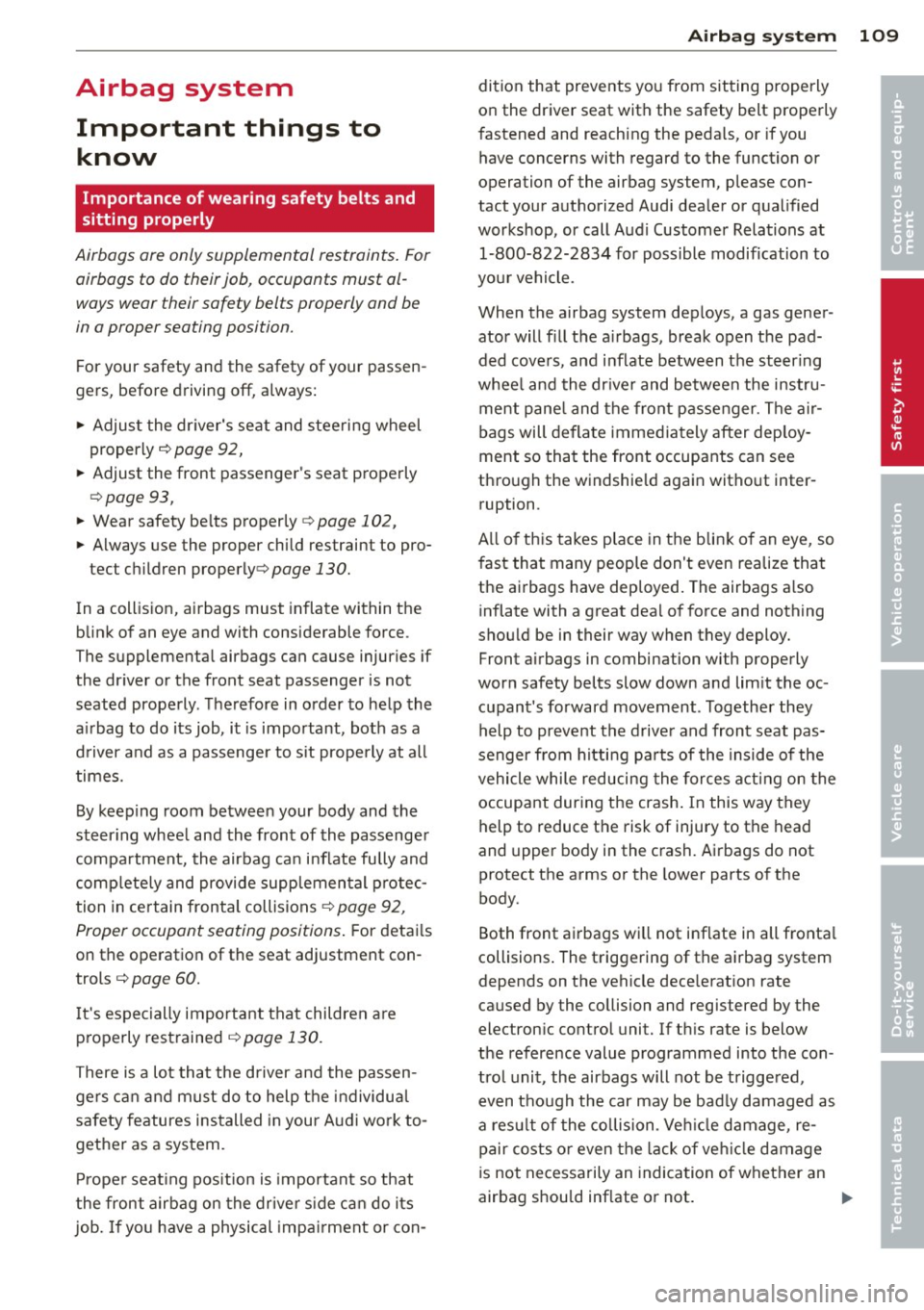
Airbag system Important things to know
Importance of wearing safety belts and
sitting properly
Airbags are only supplemental restraints. For
airbags to do their job , occupants must al
ways wear their safety belts properly and be
in a proper seating position.
For your safety and the safety of your passen
gers, before driving off, always:
"" Adjust the driver's seat and steering wheel
properly
q page 92,
"" Adjust the front passenger's seat properly
¢page 93,
"" Wear safety be lts properly ¢ page 102,
"" Always use the proper child restraint to pro-
tect children properlyq
page 130.
In a collision, airbags must inflate within the
blink of an eye and with considerable force.
The supplemental airbags can cause injuries
if
the driver or the front seat passenger is not
seated properly . Therefore in order to help the
a ir bag to do its job, it is important, both as a
driver and as a passenge r to s it properly at all
times.
By keeping room between your body and the
steer ing whee l and the front of the passenger
compartment, the airbag can inflate fully and
comp letely and provide supplemental protec
tion in certain frontal collisions
q page 92,
Proper occupant seating positions. For details
on the operation of the seat adjustment con
trols
q page 60.
It's especially important that children are
properly restrained
q page 130.
There is a lot that the driver and the passen
gers can and must do to help the individual
safety features installed in your Aud i work to
gether as a system.
Proper seating pos ition is important so that
the front airbag on the driver side can do its
job. If you have a physical impairment or con-
Airbag system 109
dition that prevents you from sitting properly
on the driver s eat with the safety belt properly
fastened and reaching the peda ls, or if you
have concerns with regard to the function or
operation o f the airbag system, please con
tact your authorized Audi dealer or qualified
workshop , or call Audi Customer Relations at
1-800-822-2834 for possible modification to
your vehicle.
When the airbag system dep loys, a gas gener
ator will f ill the a irbags, break open the pad
ded covers, and inflate between the steer ing
whee l and the driver and between the instru
ment panel and the front passenger. The air
bags will deflate immediately after deploy
ment so that the front occupants can see
through the windshie ld again without inter
ruption .
A ll of th is takes place in the blink of an eye, so
fast that many people don't even realize that
the airbags have deployed. The airbags a lso
inflate with a great dea l of force and nothing
should be in their way when they deploy.
Front airbags in comb ination with properly
worn safety belts slow down and lim it the oc
cupant's forward movement . Together they
help to prevent the driver and front seat pas
senger from hitting parts of the inside of the
vehicle while reducing the forces acting on the
occupant during the crash. In this way they
help to reduce the risk of injury to the head
and upper body in the crash. Airbags do not
protect the arms or the lower parts of the
body.
Both front airbags wi ll not inflate in all fronta l
collisions . The triggering of the airbag system
depends on the vehicle de ce lerat ion rate
caused by the collision and regis te red by the
elec tron ic control uni t. If th is rate is below
the reference value programmed into the con
trol unit, the airbags will not be trigge red ,
even though the car may be badly damaged as
a result of the collision . Ve hicl e damage, re
pair costs or even the lack of ve hicle dama ge
is not necessarily an indication of whether an
airbag should inflate or not . •
•
...
Page 112 of 236

110 Airbag sys te m
Since the cir cumstances will vary considerab ly
between one collision and anot her, it is not
possib le to def ine a range of vehicle speeds
that will cover every possible k ind and angle
of impact t hat will always trigger the airbags.
Important factors include, for example, the
nature (hard or soft) of the object which the
car h its, the ang le of impact, vehicle speed,
etc. The front airbags will also not inflate in
side or rea r collisions, or in ro ll-overs.
Al ways rememb er: Airbags will deploy only
once, and only in certa in k inds of co llisions.
Your safety belts are always there to offer pro
tection in those s ituations in which airbags
a re not supposed to deploy, or when they have
a lready deployed; for example, when your ve
hicle strikes or is struck by another vehicle af
ter the first co llision.
This is just one of the reasons why an airbag is
a supplementary restraint and is not a substi
tute for a safety belt . The airbag system
works most effect ively when used with the
safety belts. Therefore, always wear your safe
ty belts properly¢
page 101.
A WARNING
Sitting too close to the steer ing wheel or
instrument panel will dec rease the effec
tiveness of the airbags and will increase
t he risk of personal injury in a co llision.
- Never sit closer than 10 inches (2S cm)
to the stee ring wheel or instrument pan
el.
- If you cannot sit more than 10 inches
( 2 5 cm) from the steer ing whee l, investi
ga te whethe r adaptive equipmen t may
be available to help you reach the pedals
and increase your seating distance from
the steering wheel.
- If you are unrestrained, lean ing fo rward,
sitting sideways or out of position in any
way, your risk of in jury is much higher.
- You will also receive serio us inj uries and
cou ld even be killed if you are up against
the airbag or too close to it when it in
flates - even with an Advanced Airbag. -
To reduce the risk of injury when an a ir
bag inflates, always wear safety be lts
properly¢
page 104, How are safety
belts worn correctly? .
-Never let children ride unrestrained or
improperly restrained in the vehicle. Ad
just the front seats properly . If children
are not p roperly restrained, they may be
seve rely in ju red or killed when an a irbag
infla tes.
- Never ride with the back rest reclined.
-Always sit as far as possible from the steer ing whee l or the instrument pane l
¢ page 92, Proper occupant seating po
sitions.
- Always sit up right with your back against
the backres t of your seat.
- Never p lace your feet on the instrument
panel or on the seat. Always keep both
feet on the f loor in front of the sea t to
he lp preven t serio us in juries to the legs
and h ips if the airbag infla tes .
- Never re cline the front passenger 's sea t
to tra nspor t ob jec ts. Items c an al so
move into the a rea of the s ide airbag or
the front airbag during braking or in a
sudden maneuver . Objects near the air
bags can become projectiles and cause
in ju ry when an airbag inflates.
A WARNING
Airbags that have deployed in a crash must
be replaced.
- Use on ly orig inal equipment airbags ap
proved by Aud i and installed by a trained
technician who has the necessary tools and d iagnost ic equipment to properly re
p lace any airbag in your vehicle and as
sure sy stem effe ctive ness in a crash.
- Never permit salvaged or recycled air
bags to be installed in you r vehicle.